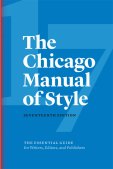Chicago Style if Already Cited Something Once Do I Have to Cite It Again

Does that mean you have to cite that source in full in a footnote (or endnote) every time?
Good news: yous don't! (Warning: some instructors might require you lot to cite in total every time, so be certain to ask before using whatever of these shortcuts.) At that place are several ways to cite a source repeatedly and relieve yourself some typing.
(Note: This post assumes you are using the notes-bibliography system. If yous are using the author-date system, just repeat the author and appointment in parentheses{(Rothfuss 2009)} every time, adding the page number you're citing{(Rothfuss 2009, 32)}.)
1. Apply a shortened form of the citation.
Let's say you wrote a footnote (or endnote) for this volume subsequently you lot quoted from page 32:
eight. Patrick Rothfuss, The Name of the Wind (New York, NY: DAW Books, 2009), 32.
The next time you cite that volume (say, in notation 12), you can give merely the author's last name, a shortened title, and the folio number:
12. Rothfuss, Name of the Air current, 50.
If Name of the Current of air is the but title by Rothfuss that you cite in your newspaper, you can leave out the title:
12. Rothfuss, 50.
This kind of shortening is recommended by The Chicago Manual of Style and Turabian's Manual for Writers, but there are a couple of even faster ways to repeat a commendation.
two. Cite the page number in the text.
Let's go back to your offset citation ofThe Name of the Air current, where you cited it in full:
8. Patrick Rothfuss, The Name of the Air current (New York, NY: DAW Books, 2009), 32.
If the side by side source you cite is this same book, y'all can simply put the new folio number in parentheses in the text of your paper. You don't have to write another annotation. Here's a sample paragraph from a paper using this format:
Rothfuss uses the word innkeeper throughout The Name of the Air current.8 In some places, he uses it because he wants to avoid using the innkeeper'due south name (50). In other places, he seems to utilise it merely for variety (116, 310).
______
8. Patrick Rothfuss, The Name of the Current of air (New York, NY: DAW Books, 2009), 32.
Important: Page numbers in parentheses in the text ever refer to the nigh recently cited source. You can go along using page numbers in parentheses as long as you're nevertheless citing that source. But as before long as you cite a different source, page numbers in the text will switch to the new source.
So let'southward say you switch to citing passages from The Slow Regard of Silent Things. When you go back to citing The Name of the Current of air, do y'all have to write out the whole citation again?
You don't! You lot can go on to use the shortened writer-title-page (or author-folio) form shown in note 12 above.
Finally, for the truly lazy at that place is one more mode to avoid typing out those titles.
3. Utilize an abbreviation.
This method is usually reserved for sources that recur many times. Permit's say your entire paper is virtually The Name of the Wind and yous cite specific page numbers on practically every page. In that example, you lot can assign the book an abbreviation to use later the starting time full commendation:
eight. Patrick Rothfuss, The Proper name of the Wind (New York, NY: DAW Books, 2009), 32. Time to come abbreviated NW.
You can then apply the abridgement any time you refer to the volume, whether in the text of your paper or in another note, no affair how many sources you lot cite in between:
One example of this is the way Rothfuss uses the discussion innkeeper.8 In The Slow Regard of Silent Things, the give-and-take never appears.9 In Wind, he seems to employ it but for variety (NW, 116, 310).
______
viii. Patrick Rothfuss, The Name of the Wind (New York, NY: DAW Books, 2009), 32. Futurity abbreviated NW.
9. Patrick Rothfuss, The Tiresome Regard of Silent Things (New York, NY: DAW Books, 2014).
Alert: Ask your instructor before using this method. (You knew that.)
4. Use ibid.
Many professional scholars use the Latin termibid. to hateful "the source I cited," but Chicago prefers the use of a short citation. Teachers who want yous to use ibid.will explain how, or you can read near it in the notes and bibliography chapter of The Chicago Transmission of Mode.
~ ~ ~
 #ChicagoStyle
#ChicagoStyle
Many libraries provide free access to The Chicago Manual of Way Online. If you aren't sure whether your school subscribes, enquire your librarian. In the meantime, click here for a gratuitous trial.
Order the hardcover here.
#ChicagoStyle for Students
 Kate Turabian'south A Manual for Writers of Enquiry Papers, Theses, and Dissertations, written specifically for students, covers every aspect of research newspaper writing, from thinking upward a topic to submitting the paper in official Chicago format. Turabian's guidelines are compatible with The Chicago Manual of Style.
Kate Turabian'south A Manual for Writers of Enquiry Papers, Theses, and Dissertations, written specifically for students, covers every aspect of research newspaper writing, from thinking upward a topic to submitting the paper in official Chicago format. Turabian's guidelines are compatible with The Chicago Manual of Style.
More advice for students
Please see our commenting policy.
Source: http://cmosshoptalk.com/2015/10/27/how-do-i-cite-the-same-source-many-times/
0 Response to "Chicago Style if Already Cited Something Once Do I Have to Cite It Again"
Post a Comment